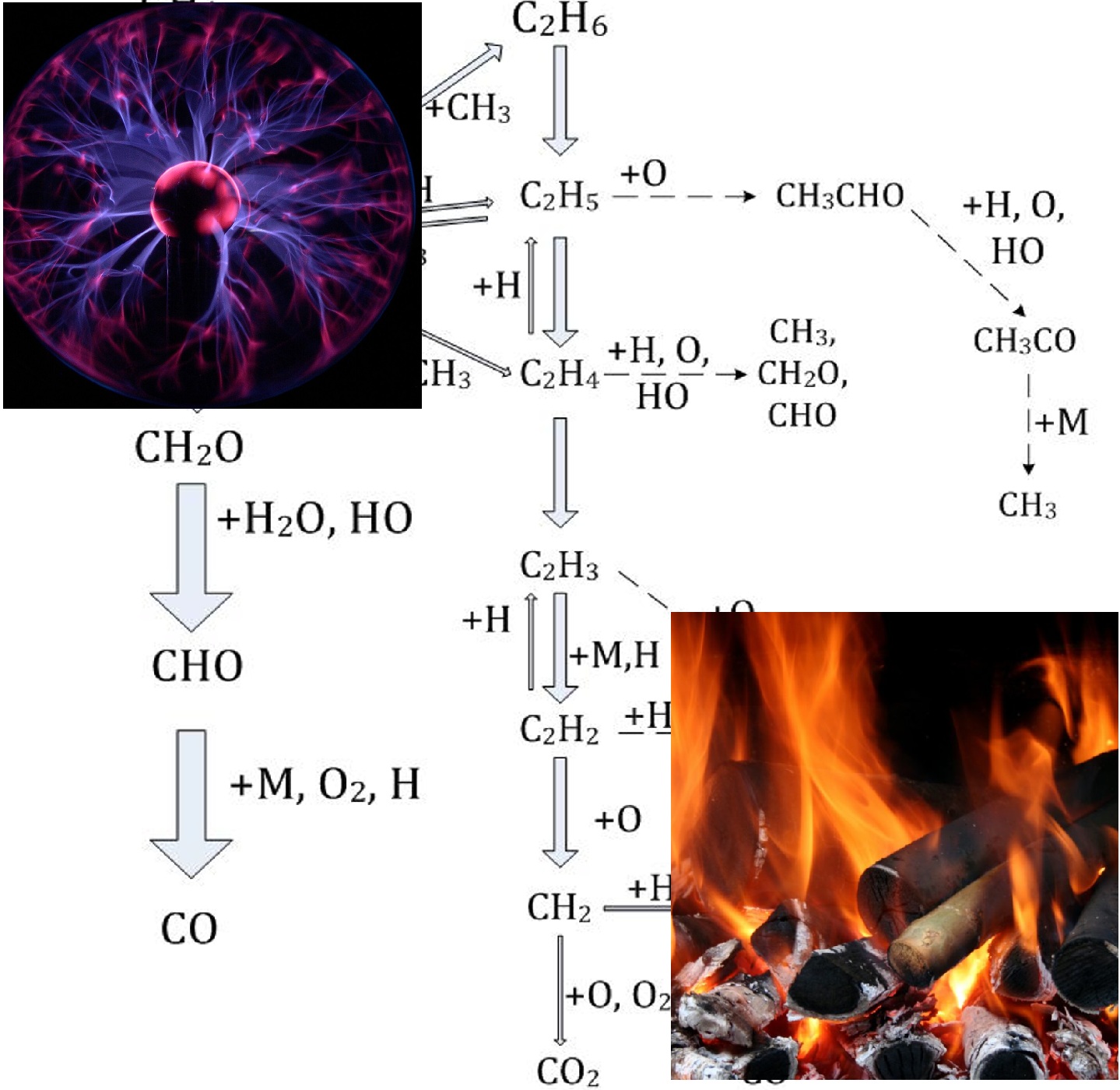INFLUENCE OF HIGH-FREQUENCY DISCHARGE ON ELECTRO-CATALYTIC COMBUSTION OF GASEOUS FUEL
DOI:
https://doi.org/10.15421/jchemtech.v33i3.321615Keywords:
electro-catalysis; combustion; intensification; catalyst; dielectric barrier discharge; high-frequency currentAbstract
Natural gas is a highly efficient energy carrier and a valuable chemical raw material. Therefore, to reduce the consumption of natural gas and increase the productivity of its use, it was proposed to use an artificially created low-temperature plasma with an ordered movement of "slow" electrons in the presence of a heterogeneous catalyst and high-frequency current. The theoretical foundations of the combustion process of gaseous fuel and the use of high-frequency current in the creation of low-temperature plasma are considered. The dependences of the change in the temperature of heated water on time at different voltages, frequencies and sinusoidal shapes of the electric discharge current during the electro-catalytic combustion of gaseous fuel are given. The energy characteristics of the process under study are determined. When using electronic catalytic combustion of natural gas with a high-frequency discharge, the optimal parameters are a discharge voltage of 2.5–3 kV, a frequency of 2.4 kHz, and a total sinusoidal shape.
References
Energy economics. https://www.bp.com/en/global/corporate/energy-economics.html
bp Energy Outlook 2024 edition. (2024). British Petroleum.
[Global gas consumption will reach a record in 2025 — МЕА]. (In Ukrainian). https://enkorr.ua/ru/news/svtove_vikoristannya_gazu_dosyagne_rekordu_2025_roku_mea/260915
Natural Gas statistics https://www.worldometers.info/gas/
Warnatz, J., Maas, U., Dibble, R.W. (2006). Combustion. Physical and Chemical Fundamentals.Modeling and Simulation. Experiments. Pollutant Formation. 4th Edition. Springer-Verlag
Warnatz, J. (1984). Rate Coefficients in the C/H/O System. In: Gardiner Jr.. W.C.. Ed.. Combustion Chemistry. Book Chapter. Springer-Verlag. New York.
Konnov, A. (2019). Yet another kinetic mechanism for hydrogen combustion. Combustion and Flame, 203, 14–22. https://doi.org/10.1016/j.combustflame.2019.01.032
Hu, X., Chen, J., Lin, Q., Konnov, A, A. (2024). Experimental and kinetic modeling study of the laminar burning velocity of CH4/H2 mixtures under oxy-fuel conditions. Fuel, 15, 132597. https://doi.org/10.1016/j.fuel.2024.132597
Kohse-Höinghaus, K. (2024). Combustion. Chemistry. and Carbon Neutrality. Chem. Rev., 123(8), 5139–5219. https://doi.org/10.1021/acs.chemrev.2c00828
Kirkpatrick, A. T., Kuo, K. K. (2024). Principles of Combustion. Wiley.
Kuo, K. K., Acharya, R. (2012). Fundamentals of Turbulent and Multiphase Combustion. Wiley.
Pitchai, R., Klier, K. (2006) Partial Oxidation of Methane. Catalysis Reviews. Science and Engineering, 13–88.
Peters, N. (2000). Turbulent combustion. Cambridge: Syndicate of university of Cambridge.
Baulch, D.L., Cobos, C.J., Cox, R.A. (1992). Evaluated kinetic data for combustion modelling. J. Phys. Chem. Ref. Data. 21. 411–734.
Hughes, K. J., Turanyi, T., Clague, A. R., Pilling, M. J. (2001). Development and Testing of a Comprehensive Chemical Mechanism for the Oxidation of Methane. J Chem Kinet, 33(9), 513–538.
Lipkowski, J., Ross, P. N. (1998). Electrocatalysis. New York: John Wiley and S. Ltd.
Clarke, T. B., Krushinski, L. E., Vannoy, K. J., Colón-Quintana, G., Roy, K., Rana, A., Renault, C., Hill, M. L., Dick Single, J. E. (2024). Entity Electrocatalysis. Chem. Rev., 124(15), 9015–9080 https://doi.org/10.1021/acs.chemrev.3c00723
Padavala, S. K. M., Stoerzinge, K. A. (2023). Role of Hydride Formation in Electrocatalysis for Sustainable Chemical Transformations. C.S. Catal., 13(7), 4544–4551. https://doi.org/10.1021/acscatal.3c00204
Viazovyk, V. (2020). Electrocatalytic intensification of burning processes for hard and gaseous fuel. 3 International scientific and technical conference «Innovative development of resource-saving technologies and sustainable use of natural resources». Petrosani, Romania, 33–35.
Viazovyk, V. (2011). Optimization of process of burning of gaseous fuel. I International Scientific and Practical Conference "Advanced Development of Science and Technology" . Przemysl. Polska, 97–99.
Stolyarenko, H. S., Vyazovyk, V. M., Vodyanyk, O. V. (2010). Electrocatalytic intensification of gaseous fuel combustion. Bulletin of the National Technical University. Kharkiv Polytechnic Institute, 13, 112–120
Viazovyk, V. (2023). Electronocatalytic intensification combustion of gaseous fuel. Journal of Chemistry and Technologies, 31(1), 186–194. https://doi.org/10.15421/jchemtech.v31i1.271226
Herzberg, G. (2012). The Spectra and Structures of Simple Free Radicals: An Introduction to Molecular Spectroscopy Dover Publications. First Edition.
Cyvin, S. J. (1968). Molecular Vibrations and Mean Square Amplitudes. Elsevier Science Ltd.
Tannous, C. (2022). Vibrations of Molecules and Solids. Université de Brest.
Wilson, E. B., Decius, J. C., Cross, P. C. (1980). Molecular Vibrations: The Theory of Infrared and Raman Vibrational Spectra. Courier Corporation
Wahab, M. A. (2022). Symmetry Representations of Molecular Vibrations. Springer Nature Singapore.

Downloads
Published
Issue
Section
License
Copyright (c) 2025 Oles Honchar Dnipro National University

This work is licensed under a Creative Commons Attribution 4.0 International License.
- Authors reserve the right of attribution for the submitted manuscript, while transferring to the Journal the right to publish the article under the Creative Commons Attribution License. This license allows free distribution of the published work under the condition of proper attribution of the original authors and the initial publication source (i.e. the Journal)
- Authors have the right to enter into separate agreements for additional non-exclusive distribution of the work in the form it was published in the Journal (such as publishing the article on the institutional website or as a part of a monograph), provided the original publication in this Journal is properly referenced
- The Journal allows and encourages online publication of the manuscripts (such as on personal web pages), even when such a manuscript is still under editorial consideration, since it allows for a productive scientific discussion and better citation dynamics (see The Effect of Open Access).

